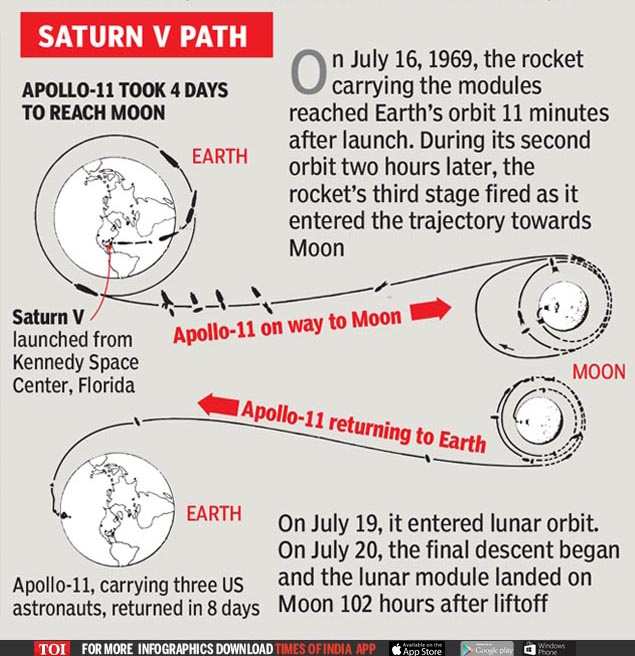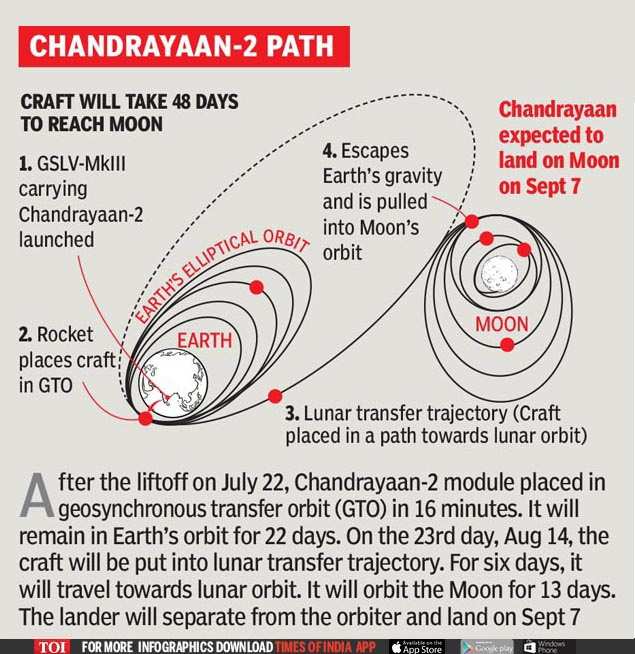Apollo-11 Took 4 Days To Reach Moon, Chandrayaan-2 Taking 48 Days. Explained

USSR’s Luna-2 craft took just 34 hours to reach Moon in 1959. Ten years later on July 20, 1969, NASA’s Apollo-11 mission carrying humans landed on Moon in just four days, 6 hours and 45 minutes. Chandrayaan-2 will take 48 days to reach Moon due to the amount of fuel it’s carrying and the speed of the lunarcraft
Have you wondered why Chandrayaan-2 will take 48 days to reach Moon whereas missions launched by USSR and US over five decades ago reached the lunar surface in under a few days?
USSR’s Luna-2 craft took just 34 hours to reach Moon in 1959. Ten years later on July 20, 1969, NASA’s Apollo-11 mission carrying humans landed on Moon in just four days, 6 hours and 45 minutes. Besides being the world’s first manned Moon mission, Apollo-11 was also the fastest trip of astronauts to Moon.
So why is Chandrayaan-2 taking more than a month? The answer lies in the build of the rocket, the amount of fuel it’s carrying and the speed of the lunarcraft.
In space, covering long distances requires high speeds and straight trajectories. For Apollo-11, NASA had used Saturn-V, a super heavy-lift launcher, to travel at more than 39,000 km per hour. The powerful rocket had a lifting capability of 43 tonnes, including the lunar module, service module and command module housing the crew capsule. Saturn V’s third stage put the modules (command with crew capsule, service and lunar modules) into the trans-lunar trajectory soon after orbiting Earth for the second time. The launcher and the lunar craft used powerful engines to reach Moon covering 3.8 lakh km in just four days. However, NASA had to pump in $185 million ($1.2 billion in 2016 value) for each Apollo mission between 1969 & 1971. Of the $185 million, it spent $110m ($690m in 2016 value) on building every Saturn V.


India does not have a rocket powerful enough to hurl Chandrayaan-2 on a straight path to Moon. It’s the reason ISRO chose a circuitous route to take advantage of Earth’s gravity, which will help slingshot the craft towards the Moon. The role of GSLV-MK-III, with only 4-ton lifting capability, was limited to putting Chandrayaan-2 (3.8 tons) in the geosynchronous transfer orbit.
Currently, the lunarcraft’s propulsion system is raising its orbit. Once the craft reaches its apogee (farthest point from Earth), and with added acceleration, the final orbit will become so stretched out that the farthest part will be very close to Moon’s orbit.
ISRO chairman K Sivan told TOI, “The spacecraft requires a minimum velocity of 11 km/second to go to Moon. Of that, 10.3 km/second is provided by the vehicle and 700 m/second is being provided by the craft’s propulsion system. Being a small engine, we are burning the engine not continuously but in short bursts to manoeuvre the craft. If we had a powerful engine like Saturn V, we could have reached Moon in a single shot.”
He added, “We are using Moon’s gravitational pull to take craft to the lunar orbit. Though we are taking 29 days to reach the lunar orbit, this is the most cost-effective way to travel to Moon.” He said "Israel's Beresheet mission launched early this year also used the same cost-effective route to Moon".
The ISRO chairman was right when he talked about the Chandrayaan-2 being a cost-effective mission as the space agency invested Rs 978 crore ($138 million- current value) in the country's second lunar mission (as compared to NASA's $185 million in 1960s -- $1.2 billion in 2016 value). Rs 375 crore ($142 million) of the total Rs 978 crore was spent on building the GSLV-MK-III rocket, a fraction compared to what NASA had spent on every Saturn V ($110 m in 1960s -- $690 million in 2016 value). However, the comparison would not be appropriate as NASA's Apollo-11 was the manned mission to Moon and Chandrayaan-2 is an unmanned lander mission. But NASA's initial few missions involving Saturn rockets launched much before Apollo-11 were unmanned missions that did not meet required objectives. Regardless of the comparison, ISRO is famous across the world for launching frugal space missions and had been successful in launching interplanetary missions like Mars Orbiter Mission in first attempt itself.
ISRO’s GSLV-MK-III: CARRYING CHANDRAYAAN-2:
The three-stage rocket is ISRO’s heaviest lifter with the capacity to carry up to 4 tonnes. Though it’s called ISRO’s ‘Bahubali’, the rocket is no match for NASA’s Saturn V. GSLV-MK-III is 43.4 m in height (as tall as a 14-storey building) and weighs 641 tons. It carried the module to the geosynchronous transfer orbit.
NASA’s SATURN-V: CARRIED APOLLO-11
NASA’s heavy-lift vehicle was a three-stage liquid-propellant rocket. As of 2019, Saturn V is the tallest (111 metre or a 36-storey building), heaviest (2,950 tonnes) and most powerful rocket ever built. It had the largest payload capacity of 140 tonnes, which included third stage and unburnt propellant to send a command and service module and lunar module to the Moon. Saturn V carried a 43-tonne payload.



No comments:
Post a Comment